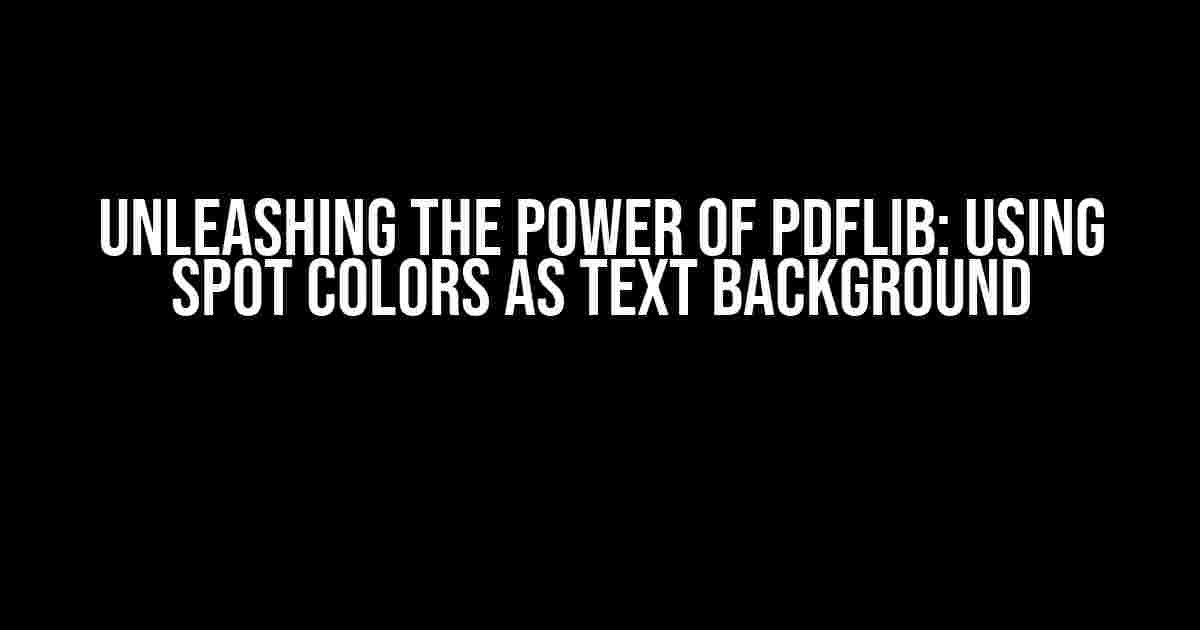If you’re a developer or designer working with PDFs, you know how crucial it is to make your documents stand out. One way to achieve this is by using spot colors as text backgrounds. In this article, we’ll dive into the world of PDFlib and explore how to harness its power to add that extra oomph to your PDFs.
What are Spot Colors?
In the world of printing, spot colors are special inks used to create unique, vibrant colors that can’t be replicated by the standard CMYK (Cyan, Magenta, Yellow, and Black) color model. These colors are typically used for logos, branding, and other design elements that require a precise color match. In the context of PDFs, spot colors can be used as text backgrounds to add visual interest and create a professional look.
Why Use PDFlib?
PDFlib is a powerful library for generating and manipulating PDFs. With its vast range of features and flexibility, it’s an ideal tool for creating dynamic, customized PDFs. By using PDFlib, you can programmatically generate PDFs with spot colors as text backgrounds, giving you unparalleled control over the design and layout of your documents.
Getting Started with PDFlib
Before we dive into the nitty-gritty of using spot colors, make sure you have PDFlib installed and configured on your system. If you’re new to PDFlib, we recommend checking out their official documentation for a comprehensive guide on getting started.
Using Spot Colors as Text Backgrounds in PDFlib
Now that you have PDFlib up and running, let’s explore how to use spot colors as text backgrounds. We’ll cover the necessary steps, code snippets, and explanations to get you started.
Step 1: Define the Spot Color
In PDFlib, you can define a spot color using the PDF_define_spot() function. This function takes three arguments: the PDF object, the name of the spot color, and the color values.
$pdf = pdf_new();
pdf_begin_page($pdf, 1, 1, 595, 842);
// Define the spot color
$spot_color_name = 'PANTONE 288C';
$spot_color_values = array(0.39, 0.69, 0.0); // R, G, B values
pdf_define_spot($pdf, $spot_color_name, $spot_color_values);
Step 2: Create a Text Object
Next, create a text object using the pdf_begin_text() function. This function takes the PDF object as an argument.
// Create a text object
$text = pdf_begin_text($pdf);
Step 3: Set the Text Background Color
To set the text background color to the spot color, use the pdf_set_text_background() function. This function takes the text object, the spot color name, and the color values as arguments.
// Set the text background color to the spot color
pdf_set_text_background($text, $spot_color_name, $spot_color_values);
Step 4: Add Text
Add your text content using the pdf_show_xy() function. This function takes the text object, the x-coordinate, the y-coordinate, and the text content as arguments.
// Add the text content
pdf_show_xy($text, 100, 100, 'This text has a spot color background!', 0);
Step 5: Close the Text Object
Finally, close the text object using the pdf_end_text() function. This function takes the text object as an argument.
// Close the text object
pdf_end_text($text);
Putting it All Together
Here’s the complete code snippet that demonstrates how to use spot colors as text backgrounds in PDFlib:
<?php
$pdf = pdf_new();
pdf_begin_page($pdf, 1, 1, 595, 842);
// Define the spot color
$spot_color_name = 'PANTONE 288C';
$spot_color_values = array(0.39, 0.69, 0.0); // R, G, B values
pdf_define_spot($pdf, $spot_color_name, $spot_color_values);
// Create a text object
$text = pdf_begin_text($pdf);
// Set the text background color to the spot color
pdf_set_text_background($text, $spot_color_name, $spot_color_values);
// Add the text content
pdf_show_xy($text, 100, 100, 'This text has a spot color background!', 0);
// Close the text object
pdf_end_text($text);
// Output the PDF
$pdf_string = pdf_get_buffer($pdf);
-header('Content-type: application/pdf');
-header('Content-Disposition: inline; filename="spot_color_example.pdf"');
-echo $pdf_string;
pdf_close($pdf);
?>
Tips and Variations
Now that you’ve mastered the basics, here are some additional tips and variations to take your spot color game to the next level:
- Use multiple spot colors**: Define multiple spot colors and use them as backgrounds for different text elements.
- Combine spot colors with CMYK**: Mix spot colors with standard CMYK colors to create unique, eye-catching designs.
- Experiment with transparency**: Add transparency to your spot color backgrounds for a more subtle, layered look.
- Use spot colors for graphics**: Apply spot colors to graphics, such as logos or icons, for added visual appeal.
Conclusion
In this article, we’ve explored the world of spot colors and how to use them as text backgrounds in PDFlib. By following the steps and code snippets provided, you can unlock the full potential of PDFlib and create stunning, professional-looking documents. Remember to experiment with different spot colors, combinations, and design elements to take your PDFs to the next level. Happy coding!
| Spot Color | R, G, B Values |
|---|---|
| PANTONE 288C | 0.39, 0.69, 0.0 |
| PANTONE 158C | 0.91, 0.56, 0.0 |
| PANTONE 2965C | 0.14, 0.47, 0.86 |
Note: The R, G, B values provided are approximate and may vary depending on the specific Pantone color and printing conditions.
This article is brought to you by [Your Name], a developer and designer passionate about creating stunning PDFs. Follow me on [social media platform] for more tutorials, tips, and design inspiration!
Frequently Asked Question
Get ready to master the art of using spot colors as text background with PDFlib!
Can I use spot colors as text background in PDFlib?
Yes, you can! PDFlib allows you to define a spot color and use it as the background color for text. This is particularly useful when you need to ensure consistent branding across your designs.
How do I define a spot color in PDFlib?
To define a spot color in PDFlib, you can use the `PDF_define_spotcolor()` function. This function takes the name of the spot color, the Pantone color value, and an optional alternate color as parameters.
Can I use a spot color as a background for a single character or word?
Yes, you can! PDFlib allows you to apply a spot color as the background for a single character or word using the `PDF_set_text_rendering()` function. This function enables you to set the text rendering mode, including the background color, for a specific text segment.
How do I ensure that the spot color is correctly output in my PDF?
To ensure that the spot color is correctly output in your PDF, make sure to specify the spot color in the `PDF_set_spotcolor()` function and set the `PDF_SET_SPOTCOLOR` option in the `PDF_begin_page()` function. This will ensure that the spot color is embedded in the PDF and correctly rendered by the output device.
Are there any limitations to using spot colors as text background in PDFlib?
While PDFlib provides robust support for spot colors, there are some limitations to consider. For example, spot colors may not be supported in all PDF viewers or output devices, and may not be editable in some PDF editors. Be sure to test your output thoroughly to ensure compatibility.







